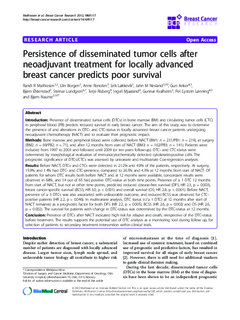| dc.contributor.author | Mathiesen, Randi Margit Ruud | |
| dc.contributor.author | Borgen, Elin | |
| dc.contributor.author | Renolen, Anne | |
| dc.contributor.author | Løkkevik, Erik | |
| dc.contributor.author | Nesland, Jahn M | |
| dc.contributor.author | Anker, Gun Birgitta | |
| dc.contributor.author | Østenstad, Bjørn | |
| dc.contributor.author | Lundgren, Steinar | |
| dc.contributor.author | Risberg, Terje | |
| dc.contributor.author | Mjaaland, Ingvil | |
| dc.contributor.author | Kvalheim, Gunnar | |
| dc.contributor.author | Lønning, Per Eystein | |
| dc.contributor.author | Naume, Bjørn | |
| dc.date.accessioned | 2019-10-14T11:16:02Z | |
| dc.date.available | 2019-10-14T11:16:02Z | |
| dc.date.created | 2013-02-27T14:44:39Z | |
| dc.date.issued | 2012 | |
| dc.identifier.citation | Breast Cancer Research. 2012, 14 (4), . | nb_NO |
| dc.identifier.issn | 1465-5411 | |
| dc.identifier.uri | http://hdl.handle.net/11250/2621954 | |
| dc.description.abstract | Introduction
Presence of disseminated tumor cells (DTCs) in bone marrow (BM) and circulating tumor cells (CTC) in peripheral blood (PB) predicts reduced survival in early breast cancer. The aim of this study was to determine the presence of and alterations in DTC- and CTC-status in locally advanced breast cancer patients undergoing neoadjuvant chemotherapy (NACT) and to evaluate their prognostic impact.
Methods
Bone marrow and peripheral blood were collected before NACT (BM1: n = 231/PB1: n = 219), at surgery (BM2: n = 69/PB2: n = 71), and after 12 months from start of NACT (BM3: n = 162/PB3: n = 141). Patients were included from 1997 to 2003 and followed until 2009 (or ten years follow-up). DTC- and CTC-status were determined by morphological evaluation of immunocytochemically detected cytokeratin-positive cells. The prognostic significance of DTCs/CTCs was assessed by univariate and multivariate Cox-regression analyses.
Results
Before NACT, DTCs and CTCs were detected in 21.2% and 4.9% of the patients, respectively. At surgery, 15.9% and 1.4% had DTC- and CTC-presence, compared to 26.5% and 4.3% at 12 months from start of NACT. Of patients for whom DTC results both before NACT and at 12 months were available, concordant results were observed in 68%, and 14 out of 65 had positive DTC-status at both time points. Presence of ≥ 1 DTC 12 months from start of NACT, but not at other time points, predicted reduced disease-free survival (DFS; HR 2.3, p = 0.003), breast cancer-specific survival (BCSS; HR 3.0, p < 0.001) and overall survival (OS; HR 2.8, p < 0.001). Before NACT, presence of ≥ 3 DTCs was also associated with unfavorable outcome, and reduced BCSS was observed for CTC-positive patients (HR 2.2, p = 0.046). In multivariate analysis, DTC status ( | nb_NO |
| dc.language.iso | eng | nb_NO |
| dc.publisher | BMC (part of Springer Nature) | nb_NO |
| dc.rights | Navngivelse 4.0 Internasjonal | * |
| dc.rights.uri | http://creativecommons.org/licenses/by/4.0/deed.no | * |
| dc.title | Persistence of disseminated tumor cells after neoadjuvant treatment for locally advanced breast cancer predicts poor survival | nb_NO |
| dc.type | Journal article | nb_NO |
| dc.type | Peer reviewed | nb_NO |
| dc.description.version | publishedVersion | nb_NO |
| dc.subject.nsi | VDP::Onkologi: 762 | nb_NO |
| dc.subject.nsi | VDP::Oncology: 762 | nb_NO |
| dc.source.pagenumber | 13 | nb_NO |
| dc.source.volume | 14 | nb_NO |
| dc.source.journal | Breast Cancer Research | nb_NO |
| dc.source.issue | 4 | nb_NO |
| dc.identifier.doi | 10.1186/bcr3242 | |
| dc.identifier.cristin | 1015000 | |
| dc.description.localcode | © 2012 Mathiesen et al.; licensee BioMed Central Ltd. This is an open access article distributed under the terms of the Creative Commons Attribution License (http://creativecommons.org/licenses/by/2.0), which permits unrestricted use, distribution, and reproduction in any medium, provided the original work is properly cited. | nb_NO |
| cristin.unitcode | 1920,12,0,0 | |
| cristin.unitcode | 194,65,15,0 | |
| cristin.unitname | Kreftklinikken | |
| cristin.unitname | Institutt for klinisk og molekylær medisin | |
| cristin.ispublished | true | |
| cristin.fulltext | original | |
| cristin.qualitycode | 1 | |

